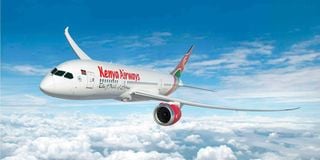Premium
Treasury settles Sh12.3bn debt by Kenya Airways

The government settled Sh12.3 billion debt on behalf of national carrier Kenya Airways.
The government settled Sh12.3 billion debt on behalf of national carrier Kenya Airways (KQ) in the financial year ending June 2023, shedding fresh light on the growing burden of struggling State-owned entities on taxpayers.
Revelations from the National Treasury show the State settled the debt that comprises Sh10.6 billion as principal and interest amounting to Sh1.7 billion.
“The national government paid Sh12.3 billion guaranteed debt on behalf of Kenya Airways during FY 2022/23. The payment is composed of Sh10.6 billion as principal payment and Sh1.7 billion as interest,” said the Treasury. Payment of the State-guaranteed loan comes after KQ defaulted on part of the $525 million loan from the Private Export Funding Corporation (Pefco), which was guaranteed by the US Exim Bank first, and Kenya government.
The KQ loan was a 12-year facility originally provided by Citi Bank and JP Morgan before Pefco took it over, with the US Exim Bank and the Kenyan government joining as guarantors.
The national carrier took out the loan in 2017 to purchase aircraft but defaulted on repayment after facing financial difficulties forcing the government to take over.
In the three months to March, the government paid Sh7.3 billion after the US Exim Bank handed a default notice to Kenya following the delayed settlement. What will worry taxpayers is that a rapidly depreciating Kenyan shilling is making it more expensive for the government to settle such external loans.
For instance, Treasury data shows KQ’s debt that will be repaid by the government increased by Sh2.08 billion in April due to depreciation of the local currency, raising the debt to Sh79.09 billion in April, a 2.7 percent increase from Sh77.01 billion in March. The heavily indebted airline has recorded losses for 10 years in a row and more than doubled the losses to hit a record Sh38.26 billion in the financial year ended December 2022 due to a rise in financing costs.
The net loss grew from Sh15.87 billion posted in 2021 and takes the national carrier’s accumulated loss to Sh172.68 billion.
The airline’s costs grew from Sh86.4 billion to Sh155 billion, mainly driven by fuel prices, which increased by 160 percent while other direct operating costs increased by Sh12.4 billion due to increased capacity.
This comes at a time the International Monetary Fund (IMF) is pushing for drastic reforms at the company to wean the airline off government bailouts by December this year to reduce the burden on taxpayers.
The IMF insists that optimal strategy for turnaround at the struggling airline should be based on least cost to the exchequer.





